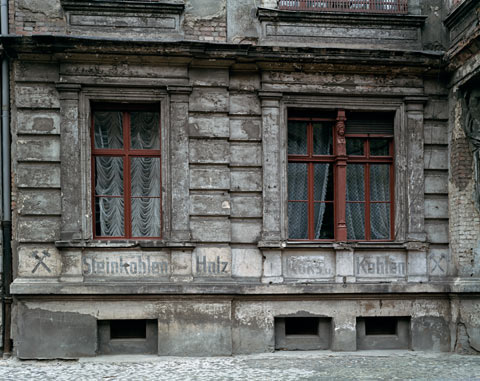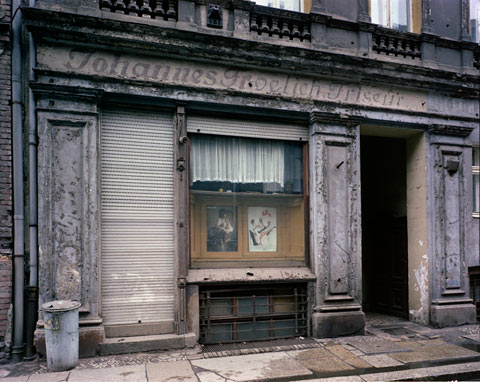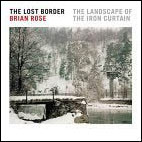Sunday, March 30, 2008
Friday, March 28, 2008
New York/East Berlin 1987
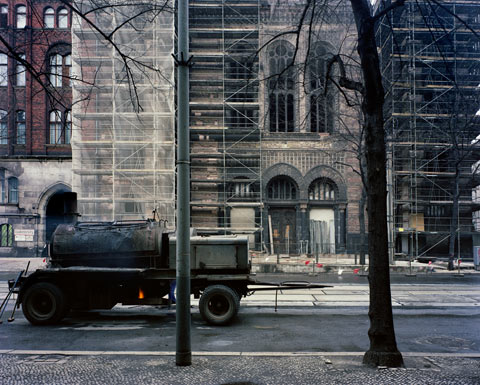
Neue Synagoge, Oranienburger Strasse, Berlin, 1987 (4x5 film)
I've been scanning a series of pictures I made in 1987 in what was then East Berlin. This was a somewhat difficult proposition given the nature of the communist state of the DDR. Carrying a view camera across the border elicited the attention of the border agents, who nevertheless, let me through. I always said that I was interested in Schinkel architecture, which was true up to a point. In retrospect I wish I had photographed Schinkel architecture back when everything over there was frozen in a post-war decrepit condition. But I did wander the streets of Berlin Mitte avoiding, as best I could, the gaze of the Volkspolizei, as I photographed the desolated neglect of the city.
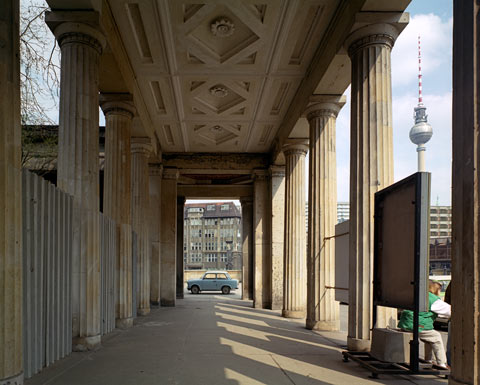
Bodestrasse, Berlin, 1987 (4x5 film)
I probably did three days of shooting all together. It was just too stressful for me. I figured at some point I would be detained for questioning, or worse. That almost happened when I went with my American friend Anamarie Michnevich in search of early 20th century modernist housing to photograph. What we found, entirely by accident, was the headquarters of the notorious Stasi, the East German secret police. Guards suddenly appeared and began pointing and calling out. We dashed down a subway stair just as a train entered and we zipped out of there. That was it for me. I gave up on doing more East Berlin photography.
I will post more photographs in the coming days.
Tuesday, March 25, 2008
New York/NYT Article
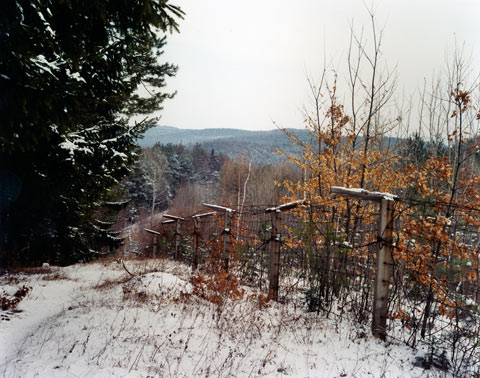
Barbed wire fence along the Austrian/Hungarian border, 1987 (4x5 film)
There was an interesting article in today's New York Times about former East Germans who attempted to escape the communist state of the German Democratic Republic (GDR) by a circuitous, and dangerous, route through Bulgaria. For those of you unfamiliar with the Iron Curtain, it was a mostly fortified border separating east and west that stretched all the way across Europe. In my Lost Border project I followed the borderline from the Baltic Sea in the north to the Adriatic in the south. That meant that I defined the Iron Curtain as running along the eastern edge of Yugoslavia where it touched Austria and Italy. Technically, Yugoslavia was not a part of the Soviet Bloc, but in practice, it was a communist country allied with the east.
I could have included the border separating Bulgaria from Greece and Turkey as well as the line between Finland and the Soviet Union. Rather than travel hundreds of miles of Finnish forest or trek through the mountains of the Bulgarian frontier, I chose to limit my project to the continuous line dividing continental Europe.
The reason that East Germans entertained the idea of fleeing across the Bulgarian border was that it was not fenced, or walled like it was in Germany, Czechoslovakia, and Hungary. While East Germans could not travel to the west, they could move about more or less freely in East Bloc countries. Many believed that the southern border offered a comparatively easy dash to freedom across open, though rugged, landscape. In reality, the border was heavily patrolled, and guards routinely shot to kill.
The Times article is based on the work of researcher, Stefan Appelius, a professor of political science at Oldenburg University, who estimates that some 100 East Germans were killed attempting to escape across the Bulgarian border. The article focuses on a couple, Olaf and Barbara Hetze, who made the attempt, unsuccessfully. They survived--she was shot, and he arrested--but eventually the West German government bought their freedom in an arrangement used frequently by the German Democratic Republic to procure western currency.
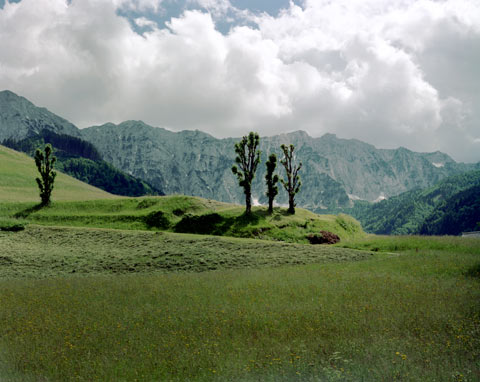
Mountainous terrain of the Austrian/Yugoslav border, 1985 (4x5 film)
Likewise, there were many attempted escapes by East Germans along the Czech, Hungarian, and Yugoslav borders. Only the Yugoslav border was unfenced, but its mountainous terrain and attentive border guards made flight near impossible. In fact, while making one of several border trips with my camera, I read in a local paper of an escapee who had been fatally shot by a Yugoslav guard, despite reaching Austrian soil. Such incidents occurred with some regularity contributing to the always tense atmosphere along the frontier, not to mention feeding international tensions between east and west.
The article is somewhat confusing in that it reads as if one had only the choice of escaping over the Berlin Wall or finding a way to run for it in Bulgaria. The Iron Curtain extended thousands of miles across Europe tracing a course through fields, forests, mountains, and even splitting villages. Escape was difficult everywhere, though, perhaps, easier in some places than others. I even recall hearing, or reading, about two men who escaped from East Berlin by traveling all the way to China where they were smuggled to the west by Canadian diplomats. They ended up in West Berlin only a few meters away from where they started.
Monday, March 24, 2008
New York/Union Square Park
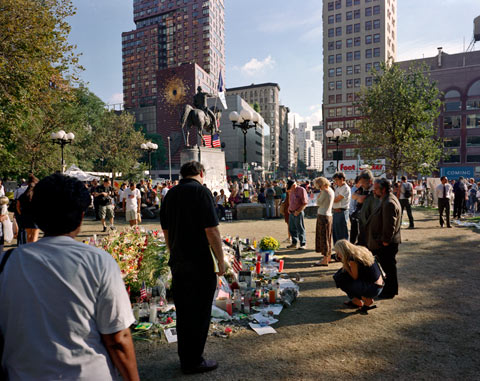
Union Square Park, New York, September 2001
19 hijackers, mostly from Saudi Arabia, trained or directed by Bin Laden in Afghanistan killed nearly 3,000 people at the World Trade Center on September 11, 2001.
As a result:
4,000 Americans now dead in Iraq. Tens of thousands of others dead. Untold number of casualties, both physical and psychological. Scores imprisoned without trial; many tortured. Vast sums of money squandered or stolen. The reputation and honor of a great nation in ruins.
And the war goes on.
Saturday, March 22, 2008
New York/Archive
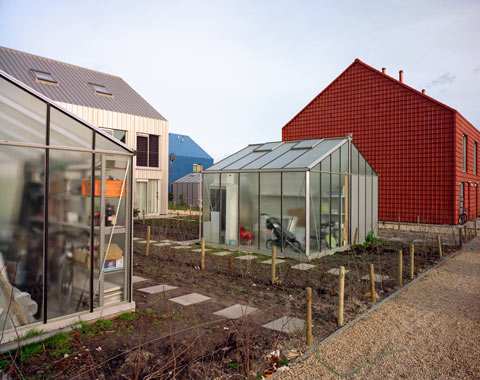
Ypenburg, The Netherlands, (4x5 film)
I've been spending a lot of time with my architectural photography archive of late. Most of the early pictures are 4x5 transparencies, the favored film format at the time. Later, I switched to negative film, which better handled mixed interior lighting, and those negs were duped on positive print film. After that, I scanned my negatives directly, and delivered digital files to my clients.
I've been scanning a lot of the older stuff for portfolio and stock purposes, and I'm catching up on a few things that were never given the attention they were due. One in particular, MVRDV's houses in Ypenburg, near the Hague, in the Netherlands. I made these pictures for my portfolio, so there wasn't a client involved.
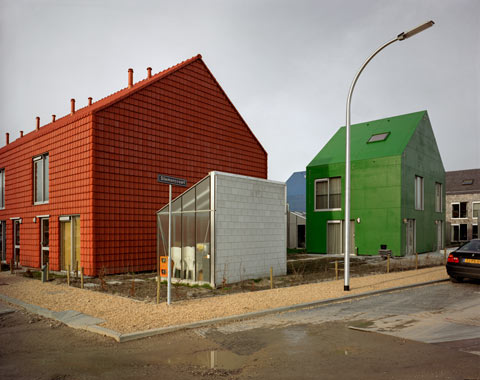
Ypenburg, The Netherlands (4x5 film)
MVRDV is one of most interesting Dutch firms, and I've photographed two other projects of their's, including the Silodam where I lived for several years before moving back to New York. The houses in Ypenburg are in one of these only-in-the-Netherlands suburban developments where many different architects are asked to each design a neighborhood within a rigorous overall plan. The effect is often a patchwork of signature styles all vying for attention and never quite cohering as a harmonious quilt.
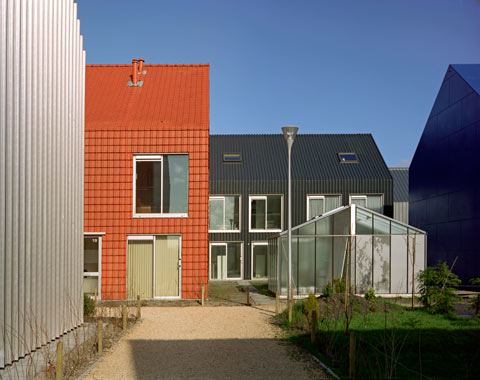
Ypenburg, The Netherlands (4x5 film)
Individually, the projects can be quite successful, as is this collection of multi-colored, variously clad houses. They are sort of ur houses in the sense that they riff off of western culture's most elemental concept of house--a box with windows, a sloping roof, and little gardens around. The architects were required to limit automobile access, so the houses are laid out on a grid of paths with parking on the perimeter of the block. I'm not sure that the layout is any better than row houses on streets, but someone thought that banishing cars from the inner circulation of the development would create a more pedestrian friendly environment. Ultimately, Ypenburg, and other Dutch suburban new towns, are very car-oriented places, though much denser than typical American suburbs.
Like most of MVRDV's work, these houses don't really express a particular design style so much as a conceptual solution. I can't speak to the usability of the design--how about the transparent storage sheds?--but I enjoyed photographing these brightly colored Monopoly houses.
Tuesday, March 18, 2008
New York/Mamaroneck
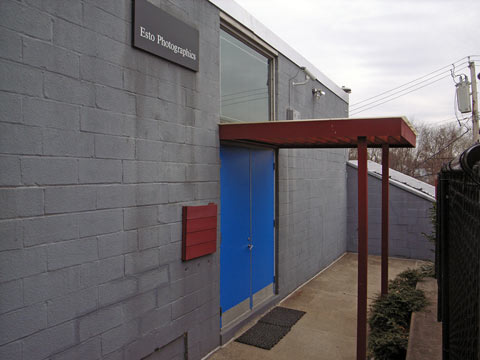
Esto Photographics, Mamaroneck, New York
Visited Esto today, the architectural photography agency, and legacy of the great photographer of buildings Ezra Stoller. I met with Erica Stoller, Ezra's daughter, who runs the place, showed my work for possible inclusion in their stock portfolio, and got a tour of the facilities. (Thanks for the hospitality.)
The building is nondescript, sits in a small parking lot just a minute from the train station. I understand it was originally a barn, but now appears more bunker-like, protecting one of the world's important repositories of architectural photographs.
Friday, March 14, 2008
New York/St. Mark's Place
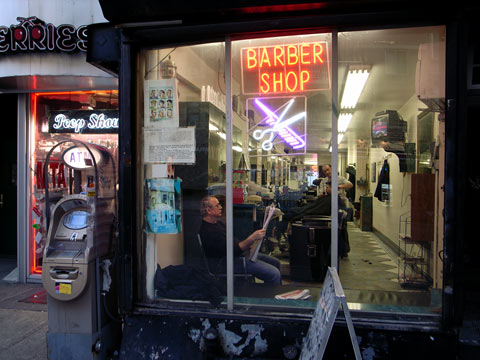
St. Mark's Place
I walked today along St. Mark's Place between 2nd and 3rd Avenues. It's the same semi-tawdry strip that it's always been despite the transformation of so much of the East Village. When I first came to New York in 1977 there were few places in the neighborhood to get a haircut--one was a small shop on St. Mark's--so I went there. It was cheap and they got the job done.
Well, surprise! It's still there, virtually unchanged.
Thursday, March 06, 2008
New York/LES
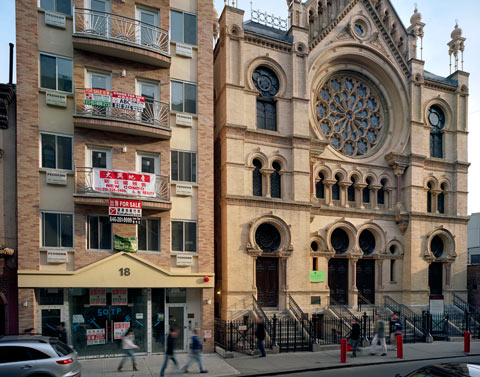
Eldridge Street Synagogue (4x5 film)
From a few weeks ago--I made this picture from the stoop of a tenement building. As I've written before, I've had a hard time figuring out how to photograph the synagogue so that one is aware of the surrounding visual cacophony of Chinatown. This image doesn't exactly do that, but I like the contrast between the old synagogue and cheap new condominium with rising sun balcony railings.
A few days back I wrote about meeting Stephen Lewis at the intersection of Fifth Avenue and 42nd Street. I just discovered his blog response:
Last week, in his weblog post, photographer Brian Rose described our recent chance late-winter-afternoon meeting on the corner of 42nd St and 5th Ave. and our follow-up conversations some days later. Brian Rose is a superlative large-format photographer with a unique understanding not only of buildings but of the natures of the cities they comprise and of the people who create them, use them, and imbue them with meaning.
Here is the whole thing on his blog Hak Pak Sak.
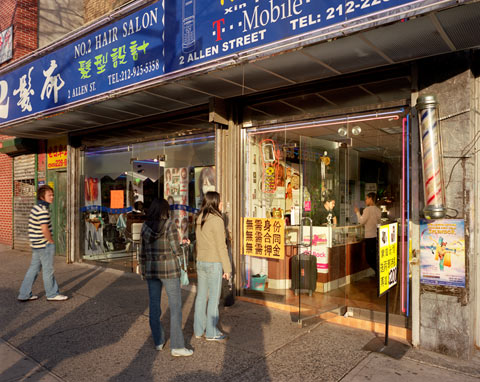
Allen Street (4x5 film)
Although the view camera is especially useful for photographing architectural subjects and landscapes, I have always tried to use it as a street camera as well. One does not, obviously, chase after action, but sets up and allows the action to move in and out of the frame.
There's often a stage-like quality working this way. In the image above, I was first attracted to the brilliant late day sunshine and bright colors of the phone shop. The frame pivots off the striped spinning barber pole with the two storefronts splitting the frame. Two women pause to look in to the first store, a shadow of a light pole falls over the plaid coat of one, and my shadow falls just to the right of the other. They appear to be looking at a man talking with someone behind the counter inside. Stage left, a man in striped shirt also pauses, anchoring that side of the frame. He looks toward the women--friends or strangers--I don't know. The relationship of people and objects coalesces into a fleeting moment, both precise and random.
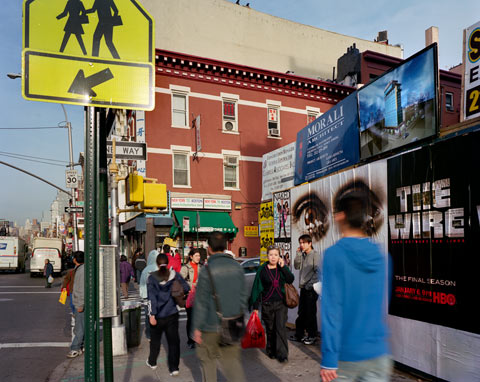
The Bowery (4x5 film)
I shot three sheets of film from the same camera position on a crowded stretch of the Bowery. I was struck first by the posters--The Wire and the eyes--and then by the rendering of the building that's under construction behind the fence. I set the shot up with the yellow sign with walking figures at top left and waited for things to happen. In the first two versions I keyed off of a pair of traffic cops wearing orange vests, and for this one, two people on cell phones amid the flow of pedestrians. The blue sweatshirted man in the foreground came from over my shoulder as I clicked the shutter his head exactly filling one of the eyes of the poster. The finished image is a multiplicity of planes slicing in different directions, spacial and flat at the same time. That's the formal rationale, but ultimately it's about this place at this moment.
Tuesday, March 04, 2008
New York/LES
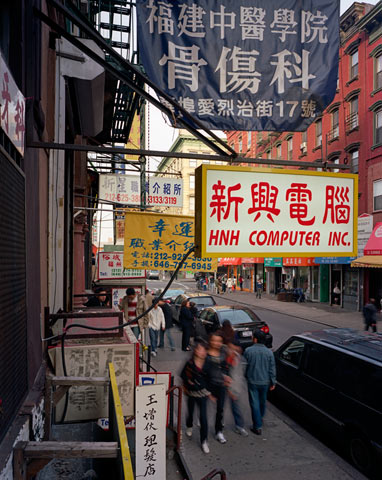
Eldridge Street (4x5 film)
Just getting around to scanning some earlier Lower East Side photographs including the view above of Eldridge Street in Chinatown.

Allen Street (4x5 film)
No more Polaroid and other digital issues
There are several interrelated things that are of great concern to me these days all related to changing technology. The first has to do with recent announcement that Polaroid has stopped producing 55 and 54 film along with the rest of their line of instant films. Polaroid 55 is a black and white peel apart negative/positive film, and 54 is a similar positive only film. I use these films routinely for architectural photography. Both are 4x5 sheet films.
Polaroid 55 is particularly useful for previewing interiors--B&W being ideal for seeing light and dark areas of the image-- and helpful when doing lighting. Moreover, the negative is especially useful for seeing critical focus with a loupe. The negative grain is much sharper than the resolution of the print. I use Polaroid 54 mostly in the field for checking exposure and, occasionally, for the satisfaction of seeing an immediate image. It's a little cheaper than Polaroid 55, though both films have gotten crazy expensive.
Now that production has stopped those of us who continue to use film are being forced by circumstances to change a tried and true method of work. A number of architectural photographers have already gone to digital cameras, and they usually bring a laptop with them to preview their work. There are several reasons I resist this route. One is that even the best 35mm digital camera (Canon EOS 1Ds Mark III) does not approach the resolution possible shooting analog and then scanning. I also don't care for the wider 35mm frame. There are digital backs that go on medium format cameras--and even view cameras--but these are prohibitively expensive for photographers like myself. The Mark III is $8,000 for the body only. Phase One backs and the like cost tens of thousands of dollars. As it is, I just spent over $3,000 for a new dual processor Macintosh.
I also resist digital because I find carrying a laptop on a shoot one more thing to lug, and one more level of distraction. I currently use a light-weight ArcaSwiss view camera, pre-packaged film, and normally carry three lenses. All this fits in a backback, with the tripod hanging off the side, that I can carry around by myself. Although a laptop provides a wonderfully detailed image for previewing focus and composition, it has the potential to become a rather intrusive presence in an otherwise streamlined shooting/thinking process. That, I should acknowledge, however, is not a problem for either Albert Vecerka or Paul Warchol, who I spoke with the other night at the ASMP panel. (See earlier post). Both use digital cameras as their main tool, but occasionly go back to the 4x5 when needed.
I will have to see where things go for me. At the moment I use the same camera, same lenses, same film, same lab, and same scanner for everything--my fine art work and architectural assignments. The process has been working really well. Now, with Polaroid disappearing, I am being forced to re-evaluate. Photography has always marched in step with technological developments. There is no way that conventional color darkroom printing compares to what is possible using Photoshop, and few would want to go back. But in the camera/film area--image capture, if you will--technology is advancing faster than quality can keep up.
